Global Private Equity Report

At a Glance
- Capital is flooding into growth equity and venture capital funds as investors seek exposure to technological change.
- A new breed of high-velocity competitor is responding by putting money to work at a frenzied pace.
- Buyout funds are getting in the game—but winning may require sharpened expertise and a new set of growth-related capabilities.
This article is part of Bain’s 2022 Global Private Equity Report
The first thing to know about growth investing is that it has rapidly emerged as one of the most dynamic segments of the private equity industry. The second thing: It’s a high-velocity game with a different set of rules.
While growth investing has always been a part of the private equity universe, it has largely stood off to one side. Buyout firms, limited by their mandates, have tended to leave growth companies and noncontrol deals to specialists or firms focused on Asia, where leveraged buyouts with majority stakes are far less common.
But the disruptive power of digital technology has forced growth equity and late-stage venture capital to the fore over the past few years, and fast-moving investors with innovative new business models have joined the battle to control this burgeoning market. The numbers are striking. Growth and venture assets under management have expanded at about twice the rate of traditional buyout AUM over the past 10 years and in 2021 comprised a full 82% of the traditional buyout total (see Figure 1).
Growth equity and venture capital assets under management have grown at around twice the pace of buyout AUM over the past decade

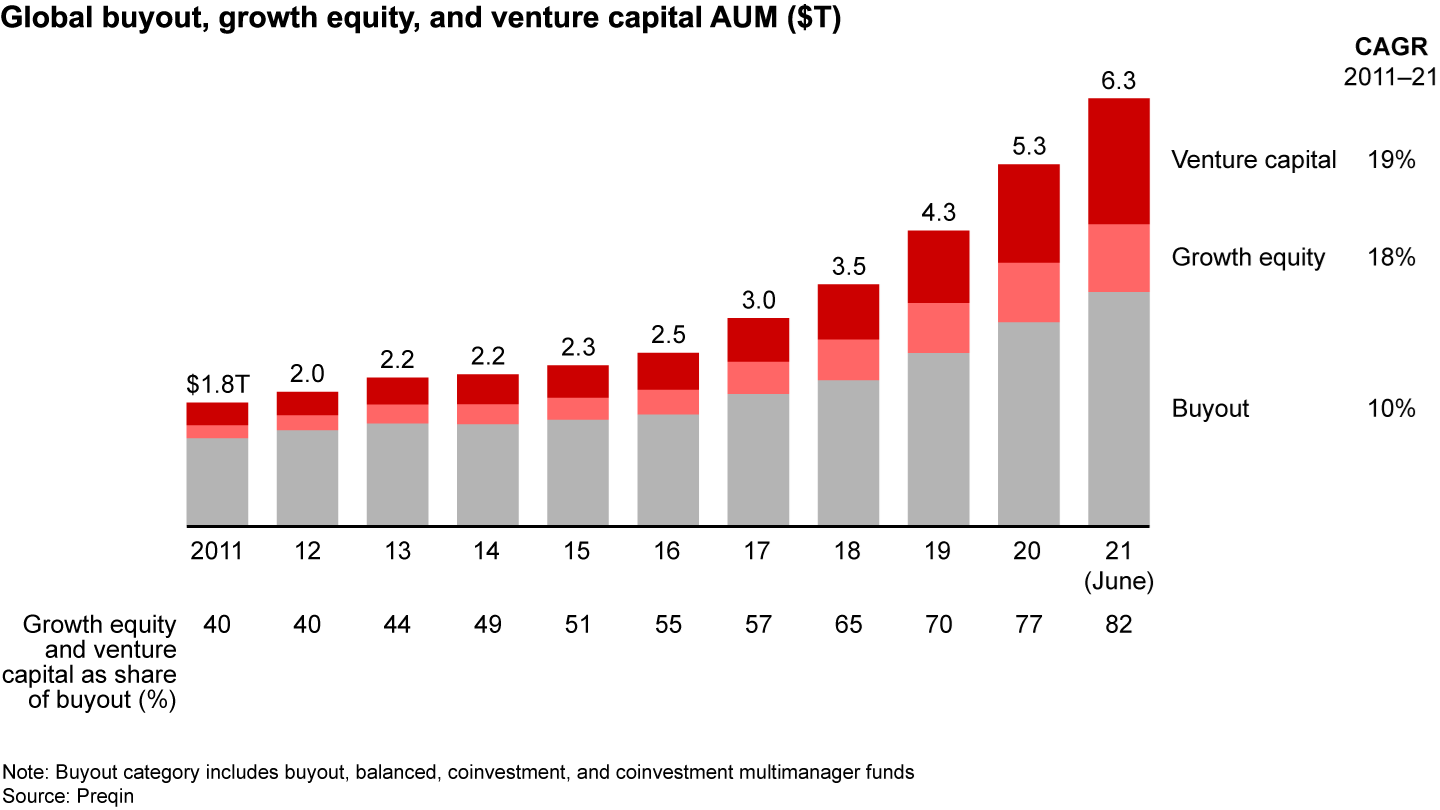
The pattern in capital deployed has been similar: Growth equity and late-stage venture capital funding has grown at 1.5 times the pace of buyout funding and now represents 61% of the traditional buyout total (see Figure 2).
Growth equity and late-stage venture funds are also putting capital to work at a faster pace than buyout funds

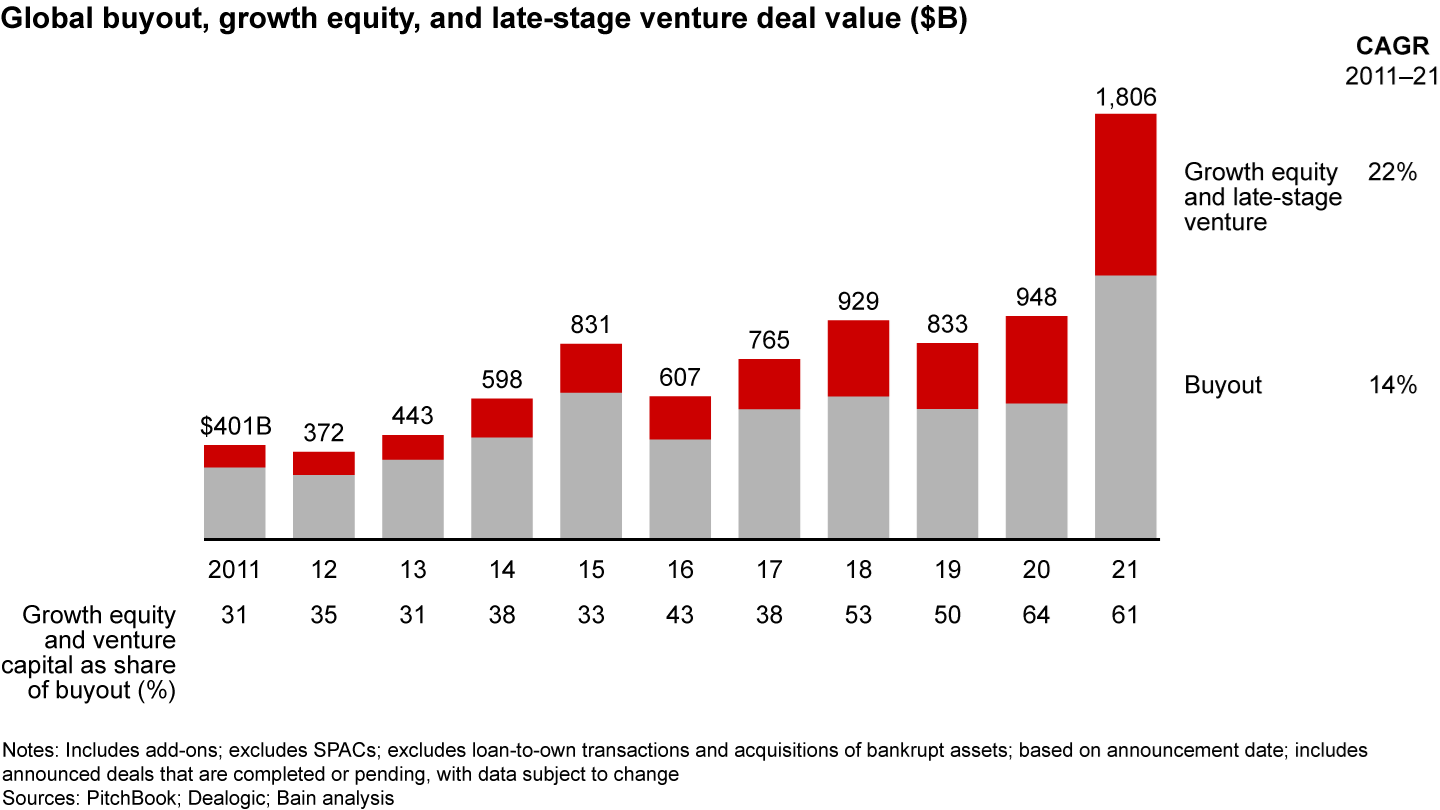
The rapid expansion has been a global phenomenon. Double-digit growth in capital deployed has occurred in North America, Europe, and Asia, across a range of sectors stretching from consumer products to financial services (see Figures 3 and 4). Capital deployed in India alone has grown 48% annually over the past five years, driven by the potential of the country’s vast Internet economy.
Growth investing has been expanding rapidly in markets worldwide


Technology is by far the largest growth investing target, but interest in financial services and healthcare is surging

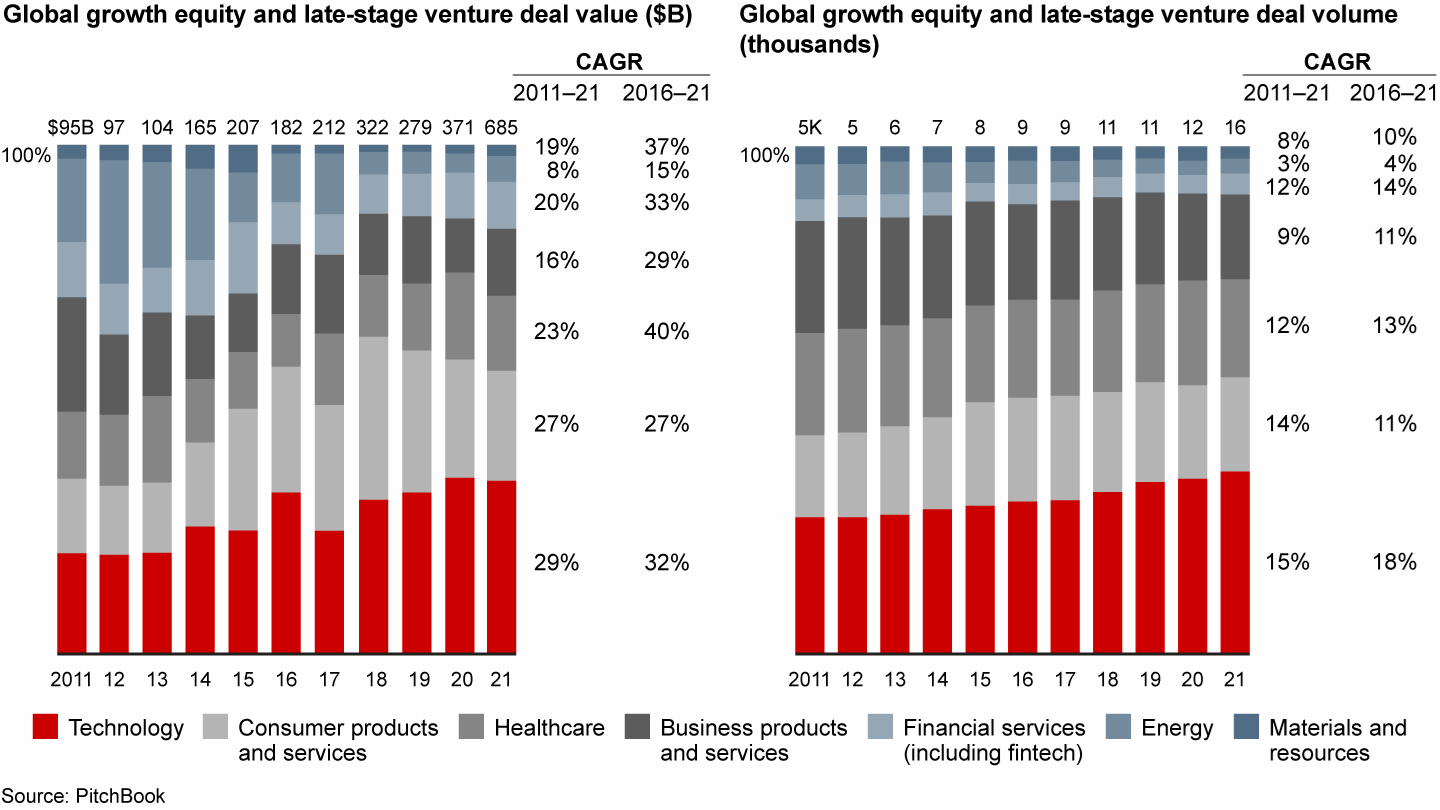
It’s frankly too early to pick winners and losers in this space. Amid the diversity of players flooding into the market, there is no “right” strategy for growth investing, and as results emerge in the coming years, we will likely see that multiple models work, much as they do in the buyout world.
But one thing is already clear: The digital disruption that’s fueling growth investing across the global economy has inspired equally disruptive business models tuned to capitalize on it. Led by a group of fast-moving hedge and crossover funds, investors in this space are finding ways to act more quickly, deploy capital more aggressively, and in some cases accept lower return hurdles, on the assumption that volume and velocity will make up for it.
That’s given this vibrant market a higher metabolism than the buyout space and is challenging traditional firms to think hard about how to compete differently. The sector’s promise has inspired a number of the industry’s top buyout firms, including Blackstone, Bain Capital, TPG, and KKR, to launch large growth funds. All have had to adjust their approach, while adding capability and talent, to compete effectively in a very different market segment.
A technology-driven flywheel
With so many different types of investors pouring into the market, it’s hard not to wonder whether the pace of technological change can continue to provide enough targets for the sheer volume of capital chasing growth opportunities. But what’s powering the growth of growth—and attracting a new breed of investor—is a belief that the digital disruption shaking the global economy is still in its early stages.
Investors are energized by the idea that technology has given companies the means to compete in entirely different ways, allowing them to take significant share of high-potential markets. And many of these disruptors are generating growth without a heavy investment in fixed capital. That gives them economics that are highly compelling to investors—or will be, at scale.
Historically, growth investing has occupied the gap between early-stage venture capital and traditional buyout investing. Often billed as the best of both worlds, it targets companies that have matured past the highest-risk start-up phase of their development but still have the potential to generate high growth and high returns. Unlike buyouts, which are predicated on control and leveraged returns, these deals are typically agnostic about control and involve little or no debt. Founders and company owners become partners, and a shared vision is often what seals the deal with a capital provider.
Investors are energized by the idea that technology has given companies the means to compete in entirely different ways, allowing them to take significant share of high-potential markets.
Over the past few years, the line between growth and buyout has steadily blurred as the size and scope of these deals have increased. Companies with disruptive business models like Stripe and Chime are opening up opportunities to take on very large incumbents in segments with vast addressable markets. They are also producing technology and software that allow other companies to reinvent themselves and how they compete. In many cases, this has led to stunning growth and a voracious appetite for capital to fuel the journey to scale. It explains why several new unicorns—companies valued at $1 billion or more—now appear on the market almost daily instead of a couple times per year.
Growing companies are also staying private longer. While in the past most growth companies eventually turned to the public markets to finance their expansion, many today are waiting and tapping the deep pools of private capital readily available to help them grow. Initial public offerings are hardly going away, but companies are reaching a much later stage of growth before subjecting themselves to the notoriously distracting and expensive IPO process. That has steadily pushed up the average deal size in the growth equity and late-stage venture markets, bringing it much closer to the range historically attractive to buyout investors targeting more mature companies (see Figure 5).
As deal sizes increase, growing companies can stay private longer, creating a structural shift in how businesses are financed

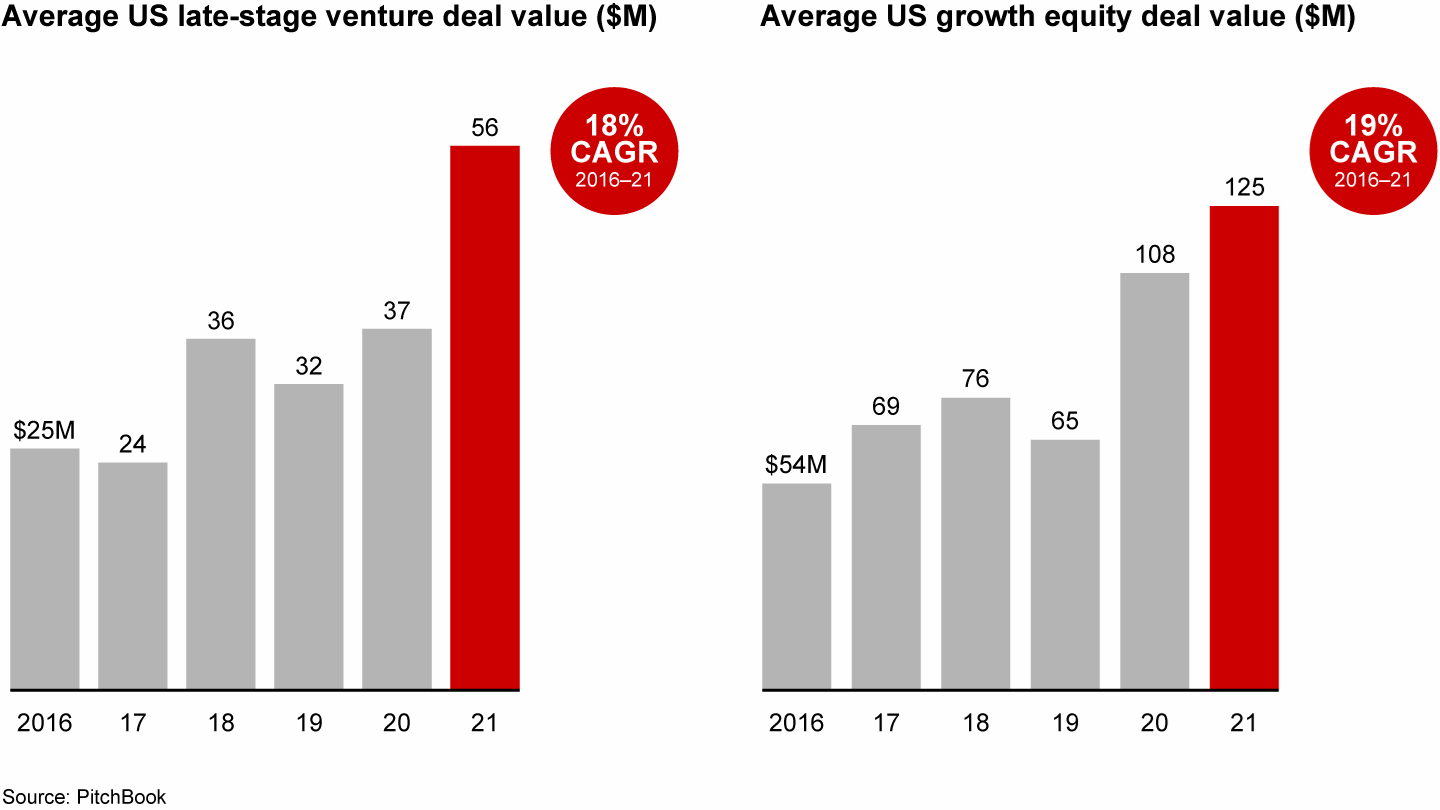
The symbiosis between companies and investors has created a flywheel effect. The rapid growth of insurgent companies and the serial emergence of unicorns is demonstrating how explosive revenue growth in this era can be—and how profitable at scale. That is attracting torrents of private capital, which is being rewarded with stronger returns across all time horizons than private equity generally (see Figure 6).
Venture capital and growth equity returns have significantly outpaced buyout returns, particularly across short time horizons

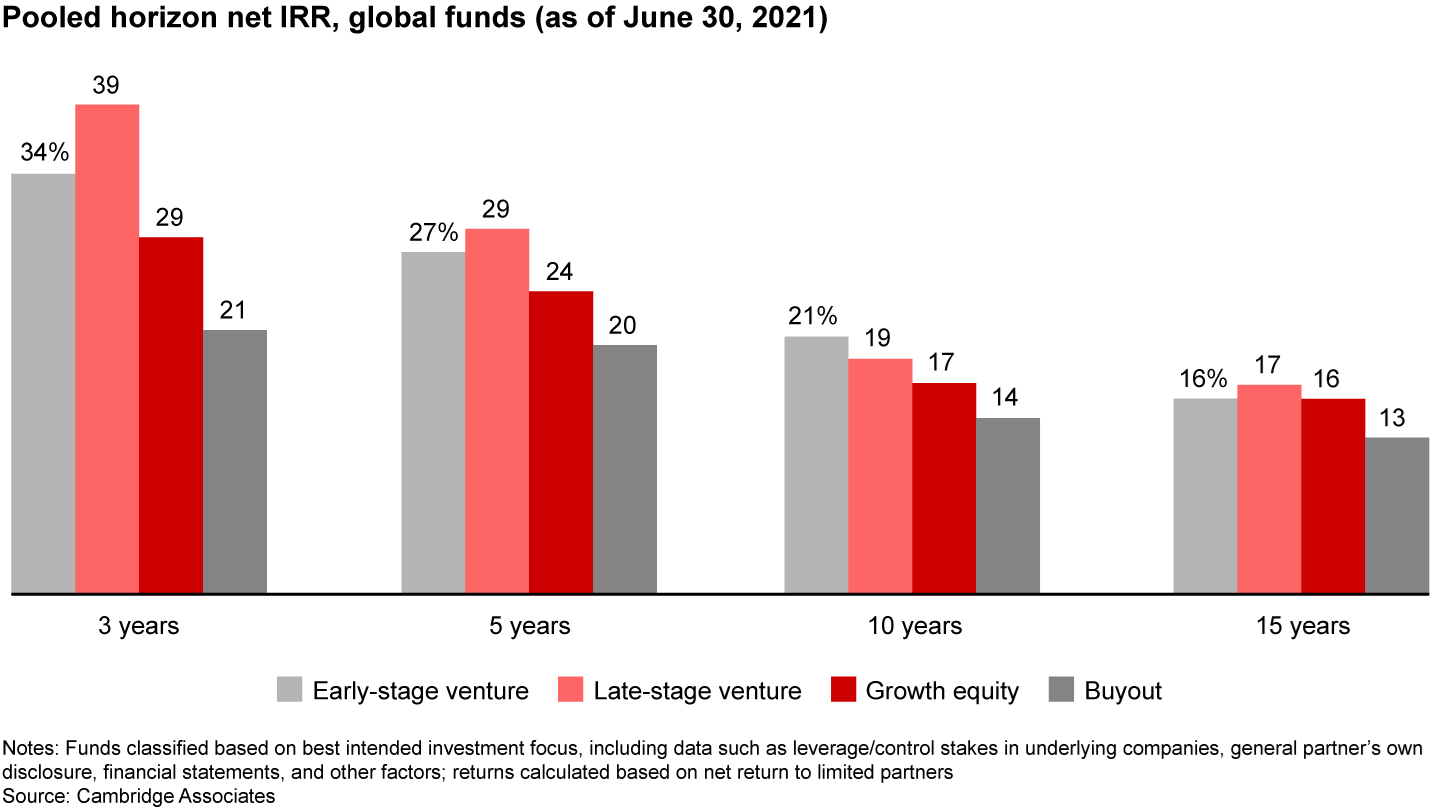
Through September 2021, the median relative velocity of value creation from earlier rounds for late-stage venture capital companies was 78%, according to PitchBook. Selling a company in 2021 on average produced a 2.7x step-up in valuation from the previous round, while IPO exits produced a 1.7x step-up. The velocity of returns has encouraged limited partners to increase their allocations every year and is prompting new investors to find ways in. The growing pool of capital and steady supply of targets keep the flywheel spinning.
Faith in disruption
The question is whether this virtuous cycle does, in fact, have the staying power to support the kinds of elevated valuations investors are paying. There’s no reliable answer, of course, and the general euphoria around growth is certainly producing some questionable transactions. But there are also reasons to believe that this surge in technology-based investing has a stronger foundation than many cycles in the past—most notably the dot-com bust at the turn of the century.
Unlike many dot-com darlings, which had zero profits and an unclear path to self-sufficiency, the companies at the center of growth investing today tend to have stronger economics and large addressable markets. A prime example is the proliferation of software-as-a-service (SaaS) companies like Snowflake and UiPath that are rapidly disrupting the software industry. SaaS vendors use the cloud to supply software and services to other companies via subscription. The model has grown quickly because it allows customers to reduce their capital expenditures on technology while giving them maximum flexibility to shift gears as markets change.
SaaS companies are capital light in that they don’t require much in the way of hard assets or fixed costs. They do need lots of capital to fund software development and customer acquisition. But once they establish scale, they have gross margins in the 70% range and embed themselves with customers in ways that are sticky and noncyclical. SaaS companies were on track to carve out 30% of the $580 billion software market in 2021, up from 17% five years earlier, and they show no sign of slowing their assault (see Figure 7). Not surprisingly, this performance and high expectations for what’s to come have made SaaS a key focus of growth investors, accounting for around 30% of total deal value in 2021.
SaaS businesses are not only disrupting the $580 billion software market but are doing so with strong economic profiles

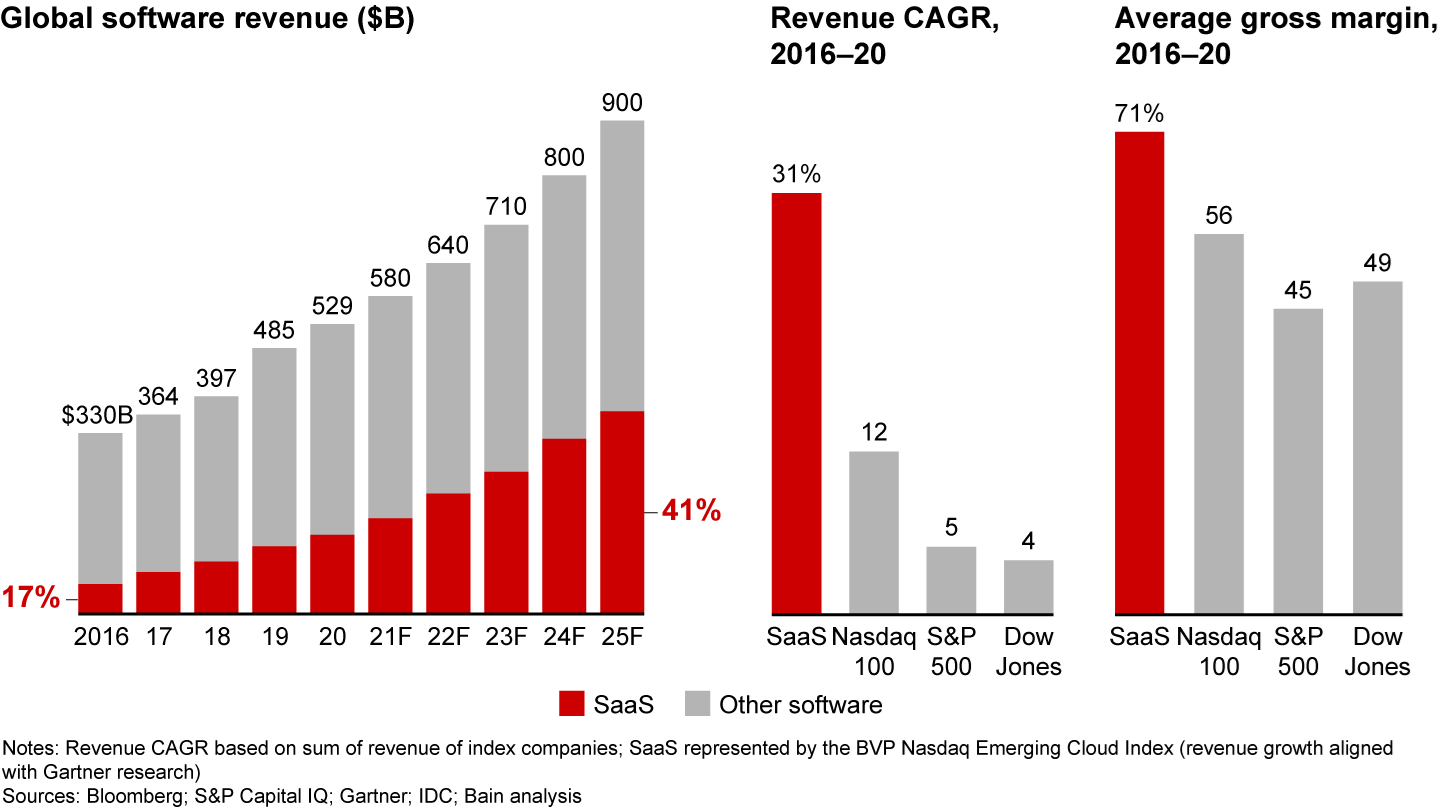
But growth and late-stage venture investors are finding targets across the global economy as technology supercharges massive old-line industries like finance, retail, restaurants, and business services. Longtime growth sectors like life sciences also continue to provide investors with a steady flow of fast-growing targets. Fintech, which has seen 33% annual growth in deal value since 2016, has joined SaaS as a particular focus of growth equity. Investors are racing to fund the new generation of technology-enabled competitors that are shaking up an industry long dominated by massive incumbents.
These upstarts are reaching into every corner of finance, a sector that accounts for more than 20% of global gross domestic product. Companies like Chime and Revolut in banking, Robinhood in trading, and Upstart in lending are redefining their subsectors and broadening access to a younger, more tech-savvy customer. An entire ecosystem of companies has reshaped payments for an era of online commerce, while start-ups embracing blockchain technology have transformed currency and how it flows through the economy. A recent PwC report on the industry showed that 90% of global financial services firms fear losing revenue to fintech challengers.
Many of these companies are still prioritizing growth over profits, but investors are willing to bet that scale will ultimately generate strong, defensible earnings. A good example is Stripe, a fintech company with explosive growth that has taken significant share from incumbents in the arcane world of electronic payments.
Headquartered in San Francisco and Dublin, Stripe offers software that makes it relatively simple for merchants to embed e-commerce capabilities and accept payments online and in mobile applications. In return, Stripe takes a tiny sliver of each payment that crosses its platform, generating a steady stream of revenue. With 14 global offices, the company can process payments from anywhere in the world and has recently begun to enter new markets, such as deposit services and lending. Gross revenue was expected to jump 50% in 2021 to $11 billion—or $2.4 billion after fees. A $600 million funding round in 2021 valued the company at more than $94 billion, a nearly threefold increase from a year earlier.
High velocity, high prices
Valuation increases like Stripe’s have attracted a broad range of growth investors. The top 15 by deal count in 2021 included a diversity of fund types (see Figure 8).
The largest growth investors in 2021 were a diverse, fast-moving group

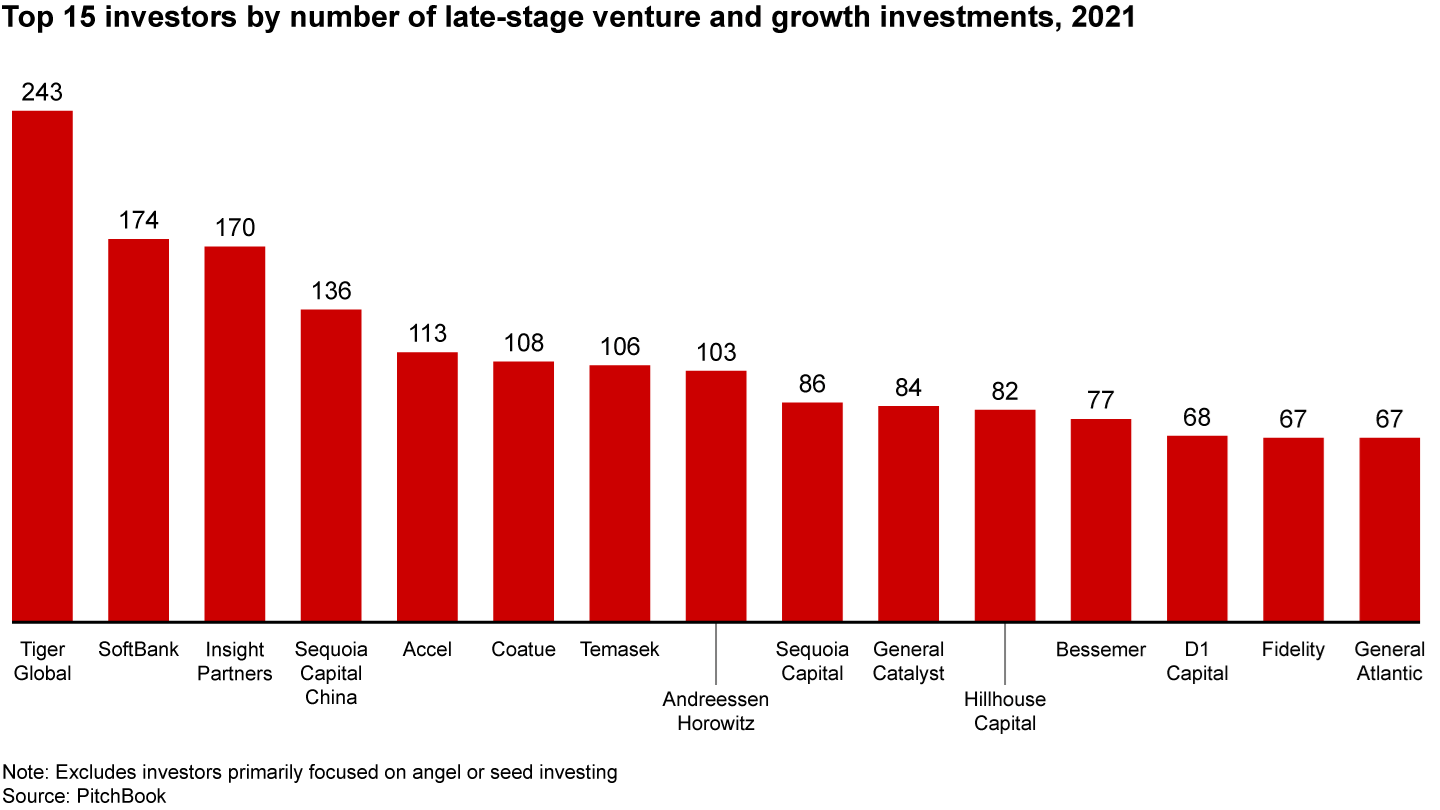
Hedge/crossover funds like Tiger Global and Coatue have been prolific, high-velocity investors. They’ve been joined by traditional growth fund Insight Partners and venture funds like Sequoia Capital, Accel, and Andreessen Horowitz. SoftBank, with $140 billion across its two Vision Funds, has entered growth investing in recent years, while Singapore’s Temasek has established itself as a significant global player, making active direct investments and participating as a limited partner. Others, like investment manager Fidelity, have also found ways to get into the game.
In terms of capital deployed and deal velocity, the leaders in the diversified buyout world are moving more cautiously. You have to expand the deal count list to the top 50 investors to find the growth funds of the global multiline private equity firms. But while these firms are adding expertise and building competence in growth, they make no apology for avoiding a radical change in style. They believe the core value-creation capabilities that have worked so well in the buyout world will ultimately produce strong top-tier results in growth investing as well.
A close look at three types of funds highlights the diversity of business models.
Hedge and crossover funds
Hedge fund and crossover investors have set the pace in growth equity in recent years and are most responsible for changing how the game is played. They put a premium on lightning-fast decision making, aggressive equity funding, and an agnostic approach to control. It is a sharp departure from the deliberative, high-touch buyout model, based on majority ownership, leverage, and active value creation.
Led by Tiger Global, which has $95 billion in AUM, they have bought more companies more rapidly than any other fund type. Their presence in the market largely explains why the velocity of investment in growth equity and late-stage venture capital was five times what it was for buyout in 2021, despite the higher risk profile of the average target company.
A few key factors characterize how these funds go to market.
- They are highly thematic, meaning investment is informed by a firmly held belief that technology—specifically disruptive software—remains significantly undervalued, despite the run-up in valuations over the past 10 years. These firms trust that insurgents will continue to change the rules of engagement in industry after massive industry, and that the companies gaining traction can continue to grab large chunks of market share for years to come.
- They’re committed to moving as quickly as possible to invest in the right opportunities, even if it means paying stretch multiples or funding companies that compete in the same vertical. Investing in both Robinhood and Public.com, for instance, is a bet on the democratization of trading and the belief that there may be room for multiple winners. It’s also a hedge: Even if only one of them prevails, the fund still wins.
- They have flexible capital that allows them to invest across business stages—seed, venture, growth, pre-IPO, and public equity. That lets them be as opportunistic as possible, in ways traditional buyout funds with more restrictive charters can’t be.
- They operate with high-caliber investment teams that are much smaller as a percentage of AUM than those at most private equity funds, especially the big ones. This ensures that they remain nimble decision makers who can pull the trigger on deals faster than the competition.
A critical component of this model is using best-in-class third-party partners. Rather than investing heavily to build internal capabilities, these funds rely on a broad ecosystem of expertise and resources for functions such as deal sourcing and due diligence. Unlike buyout funds that are used to rolling up their sleeves and getting involved in management decisions, these funds tend to take a more hands-off approach, giving founders the capital they need and allowing them to follow their vision.
They are happy, for instance, to give portfolio companies leeway to determine the expertise they need and invest where required. That’s fine with many target company founders and executives. Several have said publicly that when they were looking for fresh capital, hedge funds and crossover investors had an advantage over other bidders. They came to the table with a high degree of conviction about the target business, had a full appreciation of the opportunities ahead, and expressed confidence in the management team. Growth companies are used to speed and agility. Hedge and crossover funds are organized to deliver.
Traditional growth equity players
This set of funds has always been classified as growth investors. They were established from the start to invest in the niche between early-stage venture capital and buyout firms. Historically, however, they’ve more closely resembled buyout investors in terms of the pace of dealmaking. In recent years, they’ve responded to increased opportunity and capital availability by getting involved across funding rounds—from early-stage to buyout—and expanding geographically.
More critically, they’ve found ways to speed up their metabolism. Insight Partners, a trailblazing growth equity player that is said to be raising a new $20 billion fund, is a good example.
In 2021, Insight more than doubled the number of deals it did compared with a year earlier, while more than tripling its deal value. That made it the No. 3 player in the market in terms of deal volume, behind Tiger Global and SoftBank. What changed is that Insight very deliberately scaled up the model that had led to its earlier success so it could do more volume. It has rapidly added managing directors and teams, increasing headcount by close to 45% over the past year. It has opened offices in Silicon Valley, Tel Aviv, and London and is teaming up on deals with crossover investors like Tiger Global, Coatue, and Dragoneer in funding rounds for companies like CRED, Databricks, and BharatPe.
Insight launched in 1995 and prides itself on identifying disruptive industry trends and businesses early in their life cycle through a proprietary company database, an extensive network of industry advisers, and a “sourcing engine” of associates, who are constantly reaching out to founders and CEOs. It has long had a broad mandate to invest across growth stages, enabling the firm to get into promising businesses early. It then participates in later funding rounds, increasing involvement with its best investments over time.
While the hands-off approach of the hedge funds clearly appeals to some company owners, Insight is betting there are just as many who recognize the value of partnership with an investor that has deep expertise in a sector. The firm has invested heavily in building what it calls Insight Onsite, a group of 100 operating professionals who can provide portfolio management teams with free support. The group offers expertise in everything from strategy and commercial excellence to product development and M&A.
When Yevgeny Dibrov, the CEO of IoT security firm Armis, went looking for $1.1 billion to fund growth, Insight’s combination of industry experience and value-added operational support was highly attractive. “It is due to the depth of their domain expertise that they really understand the enterprise IoT device challenge we are looking to solve and the size of the market opportunity,” he said. That gave Insight an edge over other bidders—including corporate players. In January 2020, the firm landed a majority stake in the company alongside CapitalG and existing investors.
Buyout funds
Traditional PE firms are limited in their ability to chase growth equity deals by their fund mandates, which tend to demand controlling interests and board seats. Yet the allure of growth and the increasing maturity of the companies looking for private funding have inspired a number of diversified buyout firms to get in the game by establishing growth-specific funds with flexible mandates.
Blackstone, which manages $881 billion in assets across a diverse set of funds, is one of them. It raised $4.5 billion for Blackstone Growth, its first-ever fund devoted to growth equity, and built a team of growth specialists led by Jon Korngold, an 18-year growth equity veteran from General Atlantic. The expansion was part of a broader, firmwide shift in philosophy under Jonathan Gray, who became Blackstone’s day-to-day leader in 2018. As the Wall Street Journal reported, “For the next leg of its expansion, the firm is focused on companies with big growth prospects, even if it has to pay up for them.”
The allure of growth and the increasing maturity of the companies looking for private funding have inspired a number of diversified buyout firms to establish growth-specific funds with flexible mandates.
Not unlike the hedge funds, Blackstone has a thematic belief in growth and disruption that now runs across all of its funds. But Blackstone is also betting that it can win in growth equity without playing the high-velocity, low-touch game that distinguishes those competitors. The buyout giant has said it doesn’t plan to blanket sectors with investments like the high-velocity players. It wants to do what it does in buyout: find winning individual businesses and back each of them with talent, expertise, and significant capital.
Blackstone is, however, investing in growth-oriented capabilities. Like Insight, it plans to make full use of a firmwide portfolio support team of more than 100 operating professionals. And it recently took steps to shift that group’s focus from cost-cutting to growth. In May 2021, the firm elevated Jennifer Morgan, former co-CEO of SAP, to replace ex-GE vice chairman Dave Calhoun (who left Blackstone in 2019 to run Boeing) as head of the operations group. It has also appointed Courtney della Cava as head of talent and leadership, to identify the right expertise and advisers to support investment and portfolio teams. These moves signal a fundamental shift in emphasis toward helping companies build commercial excellence and accelerate revenue growth.
Building up branding expertise under former Droga5 executive Jonny Bauer has been one important priority. Blackstone believes that a key starting point for any business transformation is defining a company’s brand—and that doesn’t mean simply creating a better logo. It’s about helping portfolio companies define a vision for what the company will ultimately become and how to make that vision meaningful for customers.
When Blackstone helped create Candle Media, a new entertainment company led by former Disney executives Kevin Mayer and Tom Staggs, Bauer spent months on this definition process with Mayer and Staggs. They envisioned building a world-class producer of streaming content and then extending the brand into commerce, gaming, and social media. Blackstone’s historical strength in M&A helped the new company quickly purchase children’s content producer Moonbug Entertainment for $3 billion and Reese Witherspoon’s Hello Sunshine for $900 million. It also invested $60 million for an 11% stake in Will Smith and Jada Pinkett Smith’s Westbrook, which produced the 2021 film King Richard.
“There is no scaled, born-for-this-generation content-creation and commerce company, and we think we can create that,” said Joe Baratta, global head of Blackstone Private Equity, in an interview with The Information.
But the branding capabilities are also intended to benefit the firm as a whole. Bauer, for instance, has helped reposition multiple brands for Therma Holdings, a clean and affordable energy company acquired by Blackstone Energy Partners in 2020. “The brand question is relevant for every single company we’re buying, not just branded companies,” Baratta said. Knowing how to catalyze growth, in other words, isn’t just the purview of growth investors.
The evolution of growth equity is still in its early innings, making it hard to assess what will constitute a winning strategy over the long term. We’re clearly seeing a diversity of approaches, and most likely there will be room for multiple ways to win.
Firms on the outside looking in need to ask themselves several key questions:
- Have we developed the sector expertise and deep thematic insights that will help us decide where to invest?
- Do we have deep enough sourcing networks across geographies, sectors, and stages of corporate development?
- Do we have the diligence capabilities and resources to assess deals at pace and make decisions with enough conviction to win?
- Do we have a differentiated value proposition that will resonate with founders, who get to choose with whom they partner?
Growth equity is a ferociously competitive, high-stakes market, dominated by fast-moving investors unafraid to go big to win a deal. Competing against them will require commitment to investing in a specialized set of capabilities and finding ways to build deep expertise.